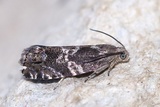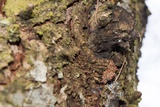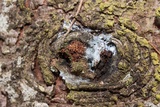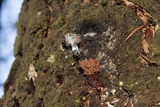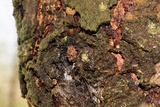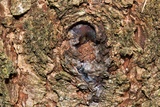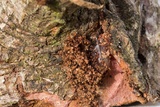Cydia grunertiana (Ratzeburg, 1868) Species
Last modified: May 30, 2024, 4:36 p.m.
First observation of this very rare species in Belgium was in AN (2003). Afterwards rarely seen. More often found as bark mines.
Adults can be confused with Cydia pactolana, therefore study of the genitals is recommended, although habitat (and food plant) are a guide to species recognition.
Details
- Classification
- Family: Tortricidae > Subfamily: Olethreutinae > Tribus: Grapholitini > Genus: Cydia > Species: Cydia grunertiana
- Vernacular names
- Roetzwarte spiegelmot (NL), Lärchenbastwickler (DE)
- First mention in Belgium
- Groenen F. & De Prins W. 2004. Cydia grunertiana, nieuw voor de Belgische fauna (Lepidoptera: Tortricidae). — Phegea 32(3): 113–115. On page 113. view page
- Status
-
Native
Distribution
Imago
Wingspan male 12.5–14.5 mm, female 13.5–16.0 mm. In external characteristics, this species differs in its more black-gray color and more compact shape than Cydia pactolana, which is more light brown to olive brown. On the underside of the rear wing, a lighter spot is present in Cydia pactolana, which is missing in C. grunertiana.
Caterpillar
In spring the larva is about 10-12 mm long, yellow or greenish-whitish and often with a reddish tinge. A brown head with a darker V-shaped mark and two dark spots on each side. The prothoracic plate, which is divided in the middle, is brown, anal plate light brown.
Bionomics
The female lays the eggs on the trunks of 15–30 year old Larix sp., mostly between 1 and 3 metres above the ground. Trees growing on sunny sides of a plantation are preferred.
The larva bores in the bark, generally just below a whorl of side branches. The bark swells and ejected frass becomes mixed with extruded resin.
The caterpillar lives under the bark in a short, densely woven feeding tunnel and hibernates at a young stage. Pupation takes place in April/May in the larval habitation at the top of the feeding passage, directly behind the cap of drill dust.
The adults come to light.
Flight periods
The adults have been observed from mid-May till July.
Habitat
Plantations and areas where the food plant grows.
